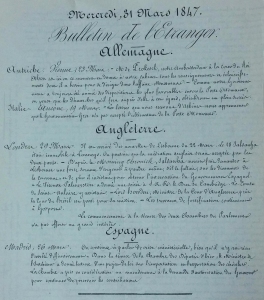Written by Clémence R. Scouten, archival processor
Charles-Louis Havas and the Agence Havas
For those who ever wondered how people got news briefs before the modern age, meet Charles-Louis Havas (1783-1858), the founder of what today is known as Agence France-Presse (AFP) Reuters. The wonderful collection of 101 lithographed news reports from 1845-1848 is a terrific example of how international news was shared before modern technology made it easy.
Based on what we found on the internet, Charles-Louis Havas was born in 1783 and after a stint in finance, he founded, in 1825, a news translation business, Bureau Havas, to service the French papers. The concept in the beginning was quite simple. He and his wife, speaking about a half dozen languages between them, could read and translate various international newspapers. His business grew through hard work, acquisition, and government relationships. Havas eventually began to hire international reporters to write original pieces, in addition to the continued translation services, for what became in 1835 the Agence Havas (one of these reporters was Paul Julius Reuter, future founder of Reuters).

Not only did Havas develop this translation/aggregation model, he innovated news distribution through a subscription formula (selling his news to small papers throughout France). Whether he did well solely due to his wits, guts, and sweat or whether his government relationships allowed him to dominate the distribution of news, he certainly became a notorious figure. Balzac openly accused Havas of having a monopoly in 1840:
“Le public peut croire qu’il existe plusieurs journaux, mail il n’y a en définitive, qu’un seul journal … Monsiuer Havas.” (The public may believe that there exists a free press, but in reality, there is only one press, Mr. Havas.)
Havas was also different in regard to his interest in advertising – of his own paper but also as a revenue stream. He managed to involve his business in a new advertising model, devoting an entire staff to advertising, paving the way for the merger with Société Générale des Annonces soon after his death. By that point, the Havas papers were as much about advertising as they were about news, if not more.
Considering the “technology” at the time, which included pigeons, it’s remarkable anyone could develop a business at all. Pigeons were heavily used to share stock market information between London, Brussels and Paris, but more substantial political and cultural news demanded a different carrier. While the railroad and telegraph revolutionized how information was transmitted, it’s still amazing to me that some of the main drivers of Havas’s success are timeless: a strong relationship with the government and an understanding of how to use advertising as an income source.

